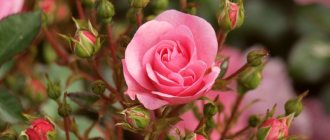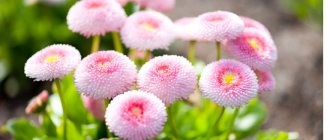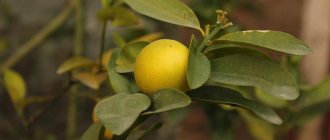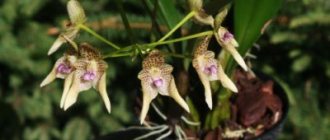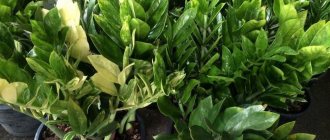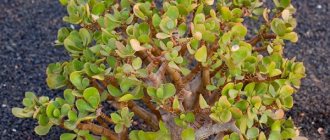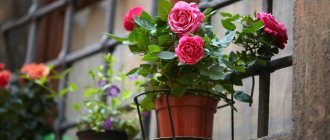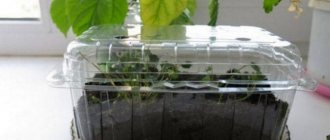In fact, there are no specific varieties of indoor roses. In their homes, flower growers grow miniature varieties of ordinary garden roses. In this article we will show the most successful varieties that take root well at home, do not take up much space and delight residents with their attractiveness and aroma.
Houseplant Echeveria - description
Echeveria is also known as the rock rose cactus, but in fact it is not a cactus, but a succulent, one of the most famous representatives of this species. For a gardener, the fact that a plant is a succulent means the following:
- It is well suited for beginners because it is very easy to care for; you can forget to water the flower a couple of times and nothing will happen to it.
- Why is that? Because this plant has dense, thick leaves that retain moisture, so even if you forget about watering a couple of times, everything will be fine.
- However, at the same time, the flower really needs abundant sunlight, since the homeland of echeveria is arid and hot areas where it received plenty of sun every day.
Echeveria belongs to the Tolstyankov genus. For example, the famous money tree belongs to the same genus.
What does a stone rose flower look like?
This species includes 120 varieties of plants, so they can differ quite significantly: in the colors of the leaves, their structure, and size. However, they all have the following indicators in common:
- The root system develops in breadth, not depth;
- Most varieties do not have stems; a rosette of leaves grows directly from the ground, from the roots;
- Reaches approximately 20 cm in height;
- The leaves are usually round in shape. They come in different shades of green, as well as pink, red and others. The structure is either glossy, smooth or fleecy. They often have a waxy coating that protects the leaves from the sun. Plaque must not be damaged or erased.
Where it grows - the birthplace of the plant
South America, the tropics, therefore has a hard time withstanding drafts: in the tropics the climate is very stable, without sudden changes in temperature.
How a stone rose blooms: when, how often
In spring, from March to May. Not all types of echeveria bloom in captivity; it is often necessary to create additional conditions to see flowering, and this is often neglected, because the main decorative value of the plant is the leaves, and blooming echeveria is not the most pompous sight, although it is pretty.
The inflorescences are small, of different shapes and colors. They come in the form of spikelets or bells in orange, red, and yellow.
The origin of the indoor rose and its features
This small plant is no different in appearance from its garden counterpart, except for its compactness. Belongs to the Rosaceae family.
Mini roses rarely reach a height of more than 50 cm. Small leaves are located on a strong, dense stem with thorns. They can be glossy or matte, but always have carved edges.
The size of the flower itself depends on the type: stamped, climbing, ground cover, bush. The latter are most often used for breeding indoors. The flower can be of very different colors - from snow-white to deep burgundy.
Usually, several varieties of indoor roses are bred in a house at the same time, which bloom, replacing each other, all year round.
The lifespan of a plant with proper care is up to 25 years.
China is considered to be the birthplace of the mini-rose, therefore, although there are versions about its origin from Southeast Asia or even Europe, it is called Chinese. The rich smell of tea gave it another name - tea room.
How to care for echeveria at home
It's not difficult, you just need to consider the following nuances.
Replanting after purchase
Yes, it needs to be done, so it is advisable to buy a stone rose in early spring, when it will best withstand the stress of moving and replanting. The transplant is carried out in the same way as all subsequent ones will be carried out, there is nothing special here, just read the “transplant” section below.
Also, after purchase, you must quarantine the plant to prevent possible pest contamination of your flower collection. Flower shops are a real feast and paradise for them, so there is a risk of bringing an infected pet from there.
A week-long quarantine, when the stone flower will stand separately from your other flowers, will allow you to observe whether everything is in order, whether the new plant is healthy, and only then place it next to others.
Lighting
Abundant, preferably diffused, but she is also not afraid of direct sunlight. The main thing is that there is enough light. But it is advisable to avoid drafts.
Temperature
The optimal temperature is 23-25⁰С, but it is difficult to overdry echeveria, because it comes from the tropics, so it easily tolerates even very high temperatures. In winter, the desired temperature is 7-10⁰С.
Humidity
Doesn't matter much because stone rose comes from dry and hot areas of the planet. On the contrary, it does not tolerate high humidity well, so it does not need to be sprayed.
Watering: how often to water echeveria
Be sure to water with soft, settled water, and so that the water does not get on the leaves - it will wash away the protective wax layer, so moisture on the leaves can cause either sunburn or, if it gets inside the rosette, rotting. You can even use bottom watering: pour water into a pan, and after half an hour drain what the echeveria “didn’t drink.”
In summer
Once a week or a little less often. The need for watering depends on two factors: the type of echeveria and how dry the earthen ball is. If the lump has dried out enough, it’s time to water it.
As for the variety: echeverias with glossy smooth leaves love water more than echeverias with fuzzy leaves.
in winter
Starting in August, the flower is watered less and less, and by winter they stop watering almost completely: a dormant period begins, and watering is needed only once a month.
Fertilizer and feeding
In spring and summer, you can feed it once a month with mineral fertilizer for cacti and succulents. The portion is halved compared to what is indicated on the package: echeveria is sensitive to overfeeding.
Why does the rose darken
This process is usually accompanied by falling leaves. And this happens for the following reasons:
- the plant is frozen, standing in a draft, or in a cold place.
- it is watered with cold water.
- she got a fungal infection.
- There are pests in the soil.
Having eradicated these causes, the plant will bloom and grow again. It is worth noting that it is necessary to choose fertilizers specifically for a specific type of flower. It is worth comparing the photo of an indoor rose on the package with your pet.
It is worth concluding that the above plant is not only beautiful and elegant, but also quite demanding. In order to keep it blooming and bright, it is necessary to put in a lot of work, care and love.
Reproduction of echeveria at home
Propagating echeveria, like any succulent, is quite simple. Here's what you'll need for this:
- A well-sharpened knife, alcohol or potassium permanganate to disinfect the knife, wood ash. All this is necessary to prevent infection: if you cut off a part of a plant (cutting, leaf, divide a rosette) with a dull knife, you will need to saw or break it off, then the cut will tighten more slowly; the absence of crushed coal powder will lead to the risk of infection; an unclean instrument also carries the risk of infection.
- Small container - the seedling will grow in it.
- Soil mixture for young plants. The soil composition options are as follows: For cuttings, rosettes: two parts of leaf soil, one part of coarse sand;
- For leaf rooting: coarse sand or peat with soil for cactus succulents;
- For seeds: peat with coarse sand (in equal proportions).
The process of reproduction in different ways is described in more detail below.
Leaf
Echeveria, like any other succulent, is easily propagated by leaves. It is best to do this in April-June. This is done like this:
- Select a leaf to propagate. A leaf from the bottom of the rosette is suitable, healthy, strong, dense, without signs of damage or pathologies.
- The leaf should be left in the fresh air for 8-10 hours.
- Then you need to place it in the ground with the base down. The soil must sometimes be moistened with a spray bottle.
- After 3-4 months, a bud will appear, from which a new plant will form, and the mother leaf will gradually dry out. The new plant can be transplanted into a larger pot and cared for as if it were a cutting. If you provide the leaf with a temperature of 23-25⁰C, rooting will occur faster.
Cuttings
A cutting is an echeveria shoot approximately 10 centimeters long. You can cut off the top. It must be cut with a sharp knife, very carefully and carefully, immediately sprinkle the cuts on the mother plant with ground activated carbon.
Next, you need to expose two or three centimeters of the stem from below, carefully breaking off the leaves there. Then you need to put the shoot on a paper napkin and leave it to ventilate and dry for 12 hours, or better yet, more. Then the cutting is placed in the ground, the soil is slightly compacted. After a day or two, carry out the first watering with warm water. Then they water, focusing on the soil: if it’s dry, it’s time to water. The cuttings take root quickly, in about a week. They are then cared for as adult plants.
Rosettes
Everything is the same as with cuttings, just instead of a shoot, a daughter rosette is cut off. The problem is that not all varieties and not all echeverias produce daughter rosettes at all, so propagation by cuttings is more often used.
Is it possible to grow echeveria from seeds?
Yes, you can, but it is difficult to get seeds from your indoor Echeveria because you will have to do artificial pollination. This is a job for professionals; it is easier for ordinary people to buy seeds.
They are planted in early spring - simply scattered on the ground, without deepening, and covered with a greenhouse. Water the soil moderately when it dries out.
If you notice that condensation has formed on the greenhouse, remove the greenhouse, wipe it and put it back.
It is necessary that the temperature around is 20-23⁰С - then seedlings will appear quickly, in about 2-3 weeks. They can be transplanted into individual pots after the formation of three independent leaves. Replant in soil with the following composition: sand (one part) and leaf soil (two parts).
Care
House roses are quite demanding in terms of maintenance conditions. Many plants die immediately after being purchased and placed in a different microclimate. Therefore, we strongly recommend that you read the information regarding care.
How to care after purchase?
In the store, a rose usually looks beautiful and healthy, so when it comes home, the new owner thinks that no effort will be required from him to maintain the appearance of the flower. This opinion is wrong, because in the store the rose is fed with special additives , and if it gets into a different microclimate, the flower may die.
In most cases, yellowing of the foliage and blackening of the buds is observed, and then the death of the plant, even if the rose looked healthy and strong.
Any varieties of roses are intended for keeping in open ground. Some varieties have been “domesticated”, but growing indoors always poses considerable difficulties.
Immediately after purchasing a shrub, you should perform a number of actions:
- Remove the gift wrapping - it can interfere with proper air exchange and cause the development of dangerous fungus.
- Dry and blackened shoots, as well as limp leaves should be removed.
- Buds and flowers also need to be cut off, because... In most cases, their flowering is created artificially; the plant spends its energy on flowering, and then dies.
- Look how many bushes are in the pot, because... Often, to create the effect of a lush bush, several plants are planted in a pot at once, which interfere with each other. Therefore, if several shrubs are found, they should be planted in separate containers.
After transplantation, the shrubs will need treatment against fungal infections using Fitosporin, as well as prevention of pests with Fitoverm solution.
Lighting
It is better to place an indoor rose on a south window, because... the plant is demanding of light. Otherwise, the shrub will bloom poorly. At the same time, avoid direct sunlight and be sure to shade the window during the period of “active” sun.
In winter, in the absence of proper lighting, lighting with phyto lamps will be required.
Temperature
During the period of active growth, indoor roses will need at least 20-25 degrees of heat, but during the dormant period, 5-8 degrees will be enough. With the onset of spring, the temperature will need to be increased gradually.
Roses by nature love open ground, so in the summer, if possible, place the pot on the balcony or in the garden . Be sure to ventilate the room with the flower, avoiding drafts.
Humidity and watering
Watering must be adjusted from the very first days.
In summer it should be more abundant, in winter - a little less. Remember that the earthen ball should always remain slightly moist, otherwise the rose may shed its leaves. To avoid harming the plant, use settled water at room temperature, including for spraying.
Watering methods should be alternated , the first time watering the plant at the root, and the next watering in the pan. Excess water must be drained.
It is also necessary to maintain a high level of air humidity - at least 60-65%. Otherwise, the bush will be attacked by pests. In sunny weather, you should not spray the rose - this way you risk getting burns on the leaves. But in winter, the shrub needs to be moistened regularly or the pot should be placed on a tray with wet expanded clay.
Top dressing
Fertilizing an indoor rose should be carried out according to the following rules:
- in winter and during quarantine the flower is not fertilized;
- during flowering, frequent feeding will be needed - every 12-15 days;
- use both mineral and organic fertilizers, alternating them with each other.
Expert opinion
Vera Ivanovna Sh
Since childhood, I have been interested in growing indoor flowers, then I decided to devote my life to landscape design and gardening.
For mineral fertilizers, you will need special fertilizers purchased in the store. You can prepare organic fertilizers yourself using a solution of cow or bird droppings in a ratio of 1:10.
How to transplant?
We carry out the transplant as follows:
- Carefully remove the bush from the pot so as not to damage the roots.
- We place drainage consisting of pebbles or expanded clay in a pre-purchased container of larger diameter.
- We fill in the soil mixture and compact it well.
- We transplant the old plant into the middle of the container and, if necessary, add a little more soil.
- We water the rose generously, after which we treat it with Epin so that the plant can more easily adapt to the new environment.
- If the bush is small, cover it with polyethylene for speedy rooting.
We carry out subsequent care in the usual way.
Priming
The growth and health of indoor roses depends on the composition of the soil. You can purchase a ready-made substrate or make it yourself.
There are 2 options for preparing soil mixture , take the following components:
- 1 part of coniferous land;
- 1 part humus;
- 1 part sand;
- 1 part leaf soil;
- 3 parts of turf land.
Second option: 4 parts of turf soil and the same amount of humus, and then add 1 part of sand.
Pot
To grow a flower and actively grow, you will need a wide pot, because... in a small pot, the roots will not be able to develop normally and absorb nutrients from the soil.
Trimming
Timely, correct pruning helps to form a beautiful, healthy bush. The procedure is carried out during bud formation, as well as immediately after flowering. There are several pruning rules:
- branches growing inside the bush must be removed;
- weak and thin shoots also need to be pruned;
- faded flowers need to be cut off at the level of the first leaf - at the location of the bud;
- The branches need to be trimmed correctly, leaving 4-5 buds on them.
Transplantation - how to replant a stone rose
The procedure is as follows:
- Prepare everything you need: a new pot, new soil, material for drainage (all this will be discussed below, what are the requirements here), a sharp tool for processing the roots, wood ash.
- Place drainage in the new “house” so that it fills it at least a quarter.
- Carefully remove the flower from the old “house”. Clean the root system of soil particles and inspect. If there are rotten parts, cut them off using sharp scissors or a knife (while grabbing a little of the apparently healthy part: fungal spores may be hiding there), carefully powder the sections with ash.
- After this, plant the echeveria in a new place of residence.
- Water a little. For the next week, do not water at all; watering should be resumed gradually.
An important point when replanting: try to touch the leaves as little as possible, because they have a waxy coating that protects the plant from the sun, and it is very easy to accidentally wipe it off.
When to replant
The frequency of replanting depends on the age of the plant: a young succulent in the form of a rose is replanted annually when it comes out of dormancy, and adult echeverias - once every two to three years (but then the top layer of soil must be updated annually).
Transplantation is also carried out in the following cases:
- If the succulent has grown out of a pot. This can be seen by the shredding of the leaves.
- To save from pests or from rotting roots.
The ideal time for replanting is spring, after emerging from the dormant period, but if the replanting is urgent, for example, to save from a disease of the root system, then they do not pay attention to the time of year.
Priming
A universal soil for succulents is suitable - light, loose, non-acidic.
You can do it yourself. You will need the following ingredients: turf, river sand (equal amounts of both) and 300 g of ground brick and crushed wood ash for every three liters of soil.
Another composition option: half the soil is soil for decorative indoor plants, the other half is one part turf and one part sand mixed with powdered clay.
You will also need a lot of drainage - expanded clay, pebbles, crushed brick - because echeveria almost does not tolerate waterlogging of the roots. Drainage should occupy ⅟₄ of the pot.
Pot
The pot will need to be flat, low and wide, because the root system of echeveria tends to spread wider rather than deeper.
A ceramic pot of light colors is desirable, because such containers heat up less and the echeveria roots will not overheat.
When replanting for the reason “it has grown from the previous container”, you need to take a container slightly larger than the previous one.
Is it possible to plant echveria in the garden (in open ground)
Yes, you can: it is not demanding on the composition of the soil (it just should not be too acidic), just plant it where it will receive enough sun. Please note that in this case the echeveria turns into an annual. It grows in the garden in summer and goes dormant in winter. However, more often than not, the stone rose is a house favorite.
For what reasons does a rose dry up?
There may be several reasons. This is weak watering or no watering. The second thing to note is the lack of fresh air.
The root system may also be damaged. Then it is necessary to completely replant the plant. If you eliminate all the above reasons, your pet will come to life again.
Echeveria diseases with photos and their treatment
Root rot
Symptoms: leaves become soft, loose, then decrease in size, turn yellow, and then fall off. These are the final stages of the development of the disease, after which the echeveria dies.
What to do: a transplant helps in the early stages of the disease. Moreover, during the transplant the following “rescue measures” are carried out:
- cut off the rotten parts of the root system, and not only what looks obviously rotten (blackened, soft), but also three to five centimeters above the rotten area, because there is most likely a fungus there too, and it will develop. Sprinkle the sections with ground activated carbon. Cut only with a sharp knife so that you do not have to saw off or break off.
- Before transplanting echeveria, you need to immerse its roots in water with the addition of a fungicide or copper sulfate for an hour. Then you need to dry the plant for 5-7 hours.
- The soil mixture and container for echeveria are thoroughly sterilized.
- Only after this they are dropped off at a new place of residence!
After replanting, for two months alternate regular water for irrigation with water to which a fungicide solution has been added - this is for prevention.
There are no more diseases, but there are care errors that can negatively affect the health of echeveria. Here they are:
- You accidentally rubbed the wax coating off the leaves or didn't look carefully and water got on them. Because of this, dark spots appear on the leaves . There is no need to do anything about this, the echeveria will recover on its own, just don’t let this happen in the future.
- You are watering your stone flower too much or keeping it in too cold conditions. Because of this, the leaves turn black at the base, they become too easy to tear off, and they lose their elasticity . It is necessary to return the temperature and watering regime to normal, otherwise rot can destroy the plant.
- Too much fertilizer or using unsettled water for irrigation. Because of this, leaf deformation . This also happens after treatment with insecticides. It is necessary to adjust the care (use settled water, reduce the amount of fertilizers), and if it is from insecticides, then just wait with the next dose of chemicals.
- Echeveria has stretched out and turned pale - this means a lack of warmth and light. In this case, you need to move the flower to a sunnier place.
- A cramped pot or too infrequent watering leads to shredding of the leaves . Requires replanting and increased watering.
Mistakes in caring for indoor roses
Choosing a healthy flower in a store or growing it from a cutting is not enough; it is necessary to protect the plant from diseases and pests and avoid mistakes in care.
| Symptom | Cause |
| Lack of flowering. |
|
| Yellowing or loss of leaf density. |
|
| Dying of leaves or parts thereof. | Improper treatment with insecticides - chemical burn. |
| Drying and falling off of leaves. |
|
| Active growth of shoots without flowering. | Excessive use of mineral and organic fertilizers. |
| Falling off of buds before flowering. |
|
Stone rose pests
These are the pests that echeveria suffers from.
Mealybug.
Symptoms of appearance: a characteristic coating on the leaves, reminiscent of lumps of cotton wool or poplar fluff. If nothing is done, such a coating will cover the entire plant, after which the lower leaves turn yellow, then the entire rosette, and the echeveria will die.
What to do:
- Isolate echeveria because the pest easily moves from one plant to another.
- Take cotton pads, soak them in a solution of water, soap (in large quantities) and alcohol and wipe off all the insects you can find from the plant.
- Next, use insecticides. Phosfamide, Actellik, Aktara are suitable. Treatments are at least two, with a break of a week, the second time a different drug is used.
Prevention: Mealybugs prefer dry conditions, so you need to make sure that it is not too dry around the echeveria; plus conduct periodic inspections of the plant for pests.
Root mealybug
Symptoms: a complex parasite, since it appears in the roots, and becomes visually noticeable only when it has proliferated enough to affect the appearance of the plant. It is visually noticeable that the echeveria no longer grows, gradually fades, then turns yellow, and wrinkles appear. A light coating can be seen on the ground.
What to do: replant the echeveria. You will need to remove it from the pot, wash the pot and tray, preferably boil it. It is necessary to sterilize the new soil (hold it in an oven for half an hour at a temperature of 100⁰C, and then for several days in a well-ventilated place) so that there are no harmful organisms there, because Echeveria is already quite weakened. When replanting, inspect the roots, cut off the rotten parts, and wash them with hot water.
Prevention: follow the recommendations for watering; once a month or a month and a half, add some insecticides (Fitoverm, Regent, Mospilan) to the water for irrigation at the rate of “one gram per two liters.”
Root-knot nematodes
Symptoms: also a root parasite, often their appearance can only be noticed during transplantation - there will be swellings on the roots, where the parasites live.
What to do: the same as in the case of root bugs. The problem is that root worms are at least somehow noticeable from the outside, but root-knot nematodes are not. Therefore, it is important to monitor compliance with preventive measures.
Prevention:
- It is necessary to use only sterilized soil and pots.
- If a new plant is purchased, it is sent to quarantine because it may be infected with pests.
- Once every two months, you need to immerse the echeveria in hot water for 30 minutes, and then let it dry for 24 hours.
What you need to know about pests
- As a rule, they start by accident: they fly into the window when it is open, you pick up a bug on your shoes or the fur of your pet, if you have one, when you return from a walk. Often pests take up residence on flowers when you buy a new green pet, because a flower shop is a great environment for pests, there are a lot of flowers, florists can’t keep track of them all.
- However, there are conditions that are more likely than others for you to have pests. This is dryness and high temperature, plus the presence of dust and the remains of other plants around the flowers. Therefore, it is important to periodically wipe the dust around the flowers and especially carefully observe those that stand near heating devices, especially in winter, when the air in the apartment is very dry.
- The surest prevention against pests is frequent inspection of the plant. Pay special attention to the lower leaves and their undersides; insects often breed there.
- Insects often lay larvae in the soil, so usually if your rock rose or any other flower or houseplant becomes infested with pests, it will need to be replanted, especially if the infestation is severe.
- The scheme for combating any pest is always the following: first, you remove adult insects from your plant by one mechanical method or another, for example, under a warm shower, or using a cotton pad soaked in a thick soap solution or alcohol, sometimes even with a vacuum cleaner (whitefly, for example) . If the lesion is small, then this is enough, but much more often it is necessary to treat with insecticides.
- Insecticides are the name of a variety of plant care products. Different insecticides are suitable for different insects, so it is better to take a photo of the insects that you have and show the photo to the seller in the store - he will select the right insecticide.
- Treatment with insecticides is usually not repeated, but two or three times. There is a pause between treatments, its duration depends on the drug, but usually 1-2 weeks. This is necessary so that your succulent can recover from the “chemical attack” on its own.
- It is best to use two or more types of chemicals, because pests easily adapt to the conditions where they live, even to chemical intervention, so it is better to use a different drug the second time, because the first may no longer be as effective.
- If the pest is especially tenacious, then cross-treatment with two types of drugs at once is allowed.
Features of cultivation
The variety of potted roses can be confusing. They are so beautiful and so attractive with their aroma that it is difficult to make the right choice, to purchase a specimen that will remain fresh and alive for a long time after purchase. First of all, we look at the leaves. In a healthy state, plants have bright green foliage with a smooth, uniform structure.
Normal development is indicated by the emerging shoots of the plant. You can take this bush; it will delight you for a long time and decorate your home.
After purchasing a decorative rose, you need to provide it with the right living conditions. Create a favorable climate in the room. The temperature must be maintained in the range of 18-25 degrees. For the first three days, the plant should be left in the same soil and without watering. Next, the soil needs to be changed; it is not suitable for the development of a potted plant. After a three-day adaptation period, the flower can be transplanted into new soil.
Popular types of echeveria: photos and names
Echeveria pleases with the unusual beauty characteristic of succulents. Here are the varieties:
Echeveria purpuzorum
This variety is unusual in color: the leaves are a rich, dark, blue-green hue, with a bright purple border.
Echeveria pulidonis
A little similar to the previous one, but much more tender. The leaves are more frequent, a delicate, silver-green hue, and the tips and border around them are pink.
Echeveria black prince
A bright variety that will look great in a loft interior: graceful, glossy, dark green, almost black leaves attract attention with their unusual elegance.
Echeveria shaviana
A very delicate variety with an unusual leaf shape for echeveria - they are more reminiscent of a peony than a rose. The color is green-blue, more golden-green towards the center, with a pink border along the edges of the leaves.
Echeveria miranda
A more laconic variety: the leaves are bright green, spring, warm in color, more elongated and sharper in shape than previous varieties.
Echeveria graceful or elegance
A variety that resembles a white rose or lotus due to its very frequent, round, green-white petals.
Echeveria lau
There is something Chinese about this echeveria; it seems as if it should decorate the chambers of an ancient Chinese beauty along with lotuses and white jade.
Echeveria pearl of Nuremberg or pearl von Nuremberg
Quite a small variety, distinguished by an unusual color: thanks to the delicate pinkish border, it seems to glow from within.
Echeveria agave
The shape resembles a lotus or even a small Christmas tree due to the upward, more elongated, sharp, lance-shaped leaves of a light green hue with pink tips.
Echeveria topsy turvy
And this variety is shaped more like coral leaves. Very miniature, looks great as an unusual desktop decoration.
Echeveria setosa or bristly
This variety has frequent leaves, but much smaller than the previous ones, thanks to which it resembles a round green cone. The leaves are not glossy, but fleecy to the touch.
Echeveria derenberga
And this variety is shaped exactly like an unusual green rose. If you read Bazhov’s tale “The Stone Flower,” this is the kind of flower Danila the Master could have carved.
Echeveria pollux
A variety with large silver leaves of a more round shape, with a pink edge. The rosette is miniature, but the leaves are large.
Echeveria affinis
Quite an exotic variety: its leaves grow upward, look more aggressive due to their sharper shape, plus they are black-green, like those of the “black prince”.
Echeveria fabiola
A classic succulent, this is the variety that people usually think of when they think of echeveria: a small, dark green rose of leaves.
Echeveria desmeta or desmetiana
Similar to the previous variety, but the color is more delicate, silver-green, even with a slight pink tint.
Echeveria pulvinata frosti
This variety has an unusual rosette shape: not a rose, like others, but rather a small tree; this variety can even be trimmed like a bonsai.
Echeveria amoena
This plant also has an unusual rosette shape: there are usually several of them in one pot, with small, round, white-pink-green leaves, they seem to fill the entire pot, it looks unusual and beautiful.
Echeveria rubella (aka Mexicana)
This variety is distinguished by the sharp, slightly curved shape of elongated bright green leaves and their unusual bright red glossy underside.
Echeveria blue
This variety is unusual in its very delicate shade of leaves: it is not only white-green, like other varieties, but also turquoise.
Echeveria red sky
The romantic name matches the appearance: the shade of the leaves here is as if the last crimson rays of sunset are burning out in an almost black sky.
Appearance
Now the appearance of a hybrid tea rose is as follows: it is a bush or standard tree with long flowering shoots. Each resulting flower is a work of art. Its elongated bud with a sharp tip, opening, reveals numerous satin or velvet petals with neatly curved edges, curled in the center into a high cone. The variety of petal colors and scents is amazing. The flowers are either medium-sized or larger, beautiful, with numerous petals forming a clearly visible central cone. Usually the flowers are single or with several lateral buds.
This may be interesting: Types and varieties of flowering Begonias


